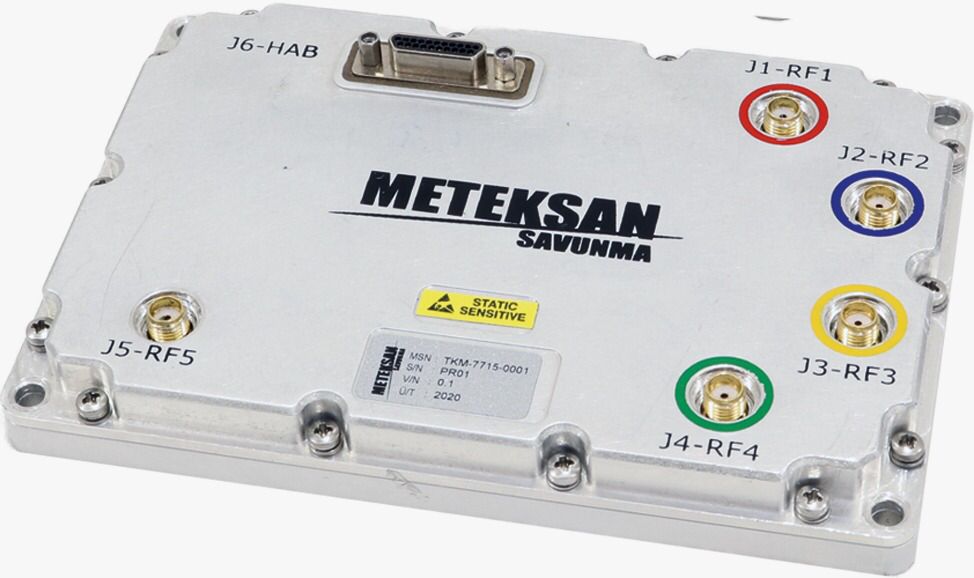Importance of GNSS in Modern Warfare Equipment
In an increasingly connected world, accurate navigation and positioning are critical across a wide range of applications—from everyday smartphone use to sophisticated military operations. Global Navigation Satellite Systems (GNSS) serve as the backbone for these functionalities.
Most military platforms depend on GNSS. When a GNSS signal is lost, systems can continue to operate for a limited time using an Inertial Navigation System (INS). However, as the system relies solely on the INS, the accuracy of the position degrades progressively over time. Loss of GNSS signals acquisition ability may cause many platforms to fail their mission.
GNSS Signal Jamming
GNSS jamming is heavily used in warfare to disable the enemy’s access to reliable positioning, navigation and timing services. In conflict zones, disrupting GNSS signals through jamming can prevent enemy units from using satellite-based systems to coordinate movements, target strikes. Numerous examples demonstrate how jamming can severely impact both civilian and military operations involving military platforms.
In modern warfare, multiple jammers can be deployed on the battlefield. As the number of jammers increases, the number of CRPA (Controlled Reception Pattern Antenna) elements and anti-jam channels required to counter these threats must also increase to maintain effective countermeasures.
Consequently, developing anti-jamming GNSS systems to maintain military platform performance in jamming environments is essential.
Meteksan Defence Anti-Jamming GNSS Solution
Meteksan Defence developed and produced platform-specific GNSS antennas, anti-jamming GNSS units (AGNOSIS), GNSS receiver systems with anti-jamming and anti-spoofing capabilities.
In the Meteksan Defence AJ-GNSS solution in order to suppress jamming signals, spatial filtering methods are employed. Phased array antennas are used for spatial filtering with respect to incoming signal direction, and jamming signals are separated from GNSS signals. Depending on the number of antennas used for spatial filtering, multiple jamming signal can be nullified simultaneously.
Meteksan Defence designs custom and reliable antenna solutions and signal processing units that can be integrated to work with different GNSS receivers, especially for different platforms and tough missions. The company designs custom and reliable antenna solutions with advanced design infrastructure for modeling and simulation and near/far antenna test & measurement environments.
Conformal/Blade antennas are designed specifically for the geometry of the platform, featuring an aerodynamic structure tailored to air/naval/land platforms. These antennas optimize the radiative beam based on placement and operational requirements.
Meteksan Defence’s Anti-jamming GNSS solution which is called AGNOSIS, is the most effective and reliable jam-resistant global positioning system in the market. AGNOSIS has features such as 4, 8 or 16 Antenna Array Configuration, Multi-Frequency Band and Multiple Satellite System support simultaneously, beam nulling, pulse blanking, frequency notch anti-jamming techniques, external GNSS Receiver support, or embedded Multiband GNSS receiver.
AGNOSIS units support all frequency bands simultaneously. In each of the frequency bands, independent beam-nulling can be done simultaneously. For example, the beam nulling method applied for the GPS band and GLONASS band are independent of each other, so that the performance of each band is optimized separately, and in practice resistance to more jammers can be achieved.
5 different frequencies are simultaneously protected hence there is no need to turn off another frequency to operate the system at one frequency.
3 different and simultaneous anti-jamming techniques which are automatically activated, have different advantages are on duty at the same time supported in GNSS Anti-Jam units.
These methods are not alternatives to each other and have different advantages. The methods can be used simultaneously and are fully automatically adaptively activated by the system according to the jammer scenario. In this way, the best possible anti-jammer capability can be achieved.
Frequency Bands Supported by GNSS Anti-Jam Units
An Anti-Jam GNSS unit can operate with different number of frequency bands which is very important for GNSS receiver performance.
In addition to the general frequency bands such as L1, L2, and L5, the sub-bands of these bands also have different GNSS signals at nearby frequencies, in other words, GPS L1CA (1575.42MHz), GLONASS G1(1598-1605 MHz), BEIDOU B1I (1561 MHz).
The methods of processing these bands also change the jamming durability considerably.
| FREQUENCY BANDs | Central Frequency (MHz) |
| GPS L1CA | 1575.42 |
| GPS L2C | 1226.7 |
| GLONASS G1 (FDMA) | 1598.0625 – 1605.37 |
| GLONASS G2 (FDMA) | 1242.9375 – 1248.625 |
| GALILEO E1 | 1575.42 |
| BEIDOU B1 | 1561.098 |
Supported Frequency Bands by Meteksan Anti-Jam GNSS
The reason for increasing the number of bands is basically to increase the total number of satellites that can be tracked by the GNSS receiver. Since each GNSS uses different frequency bands, different signal modulation techniques and different access methods (frequency, code), by this diversity it becomes more difficult to jam each band at the same time. Consequently, if certain bands remain unaffected by jamming, the GNSS receiver can continue to produce a solution using the available signals.
The key factor here is the maximum number of frequency signals that an anti-jam unit can support simultaneously. Even though conventional anti-jam units may support multiple bands, they may be switching a specific subset of these bands by user selection, rather than processing all the bands simultaneously. In this case, based on the user’s selection, the conventional anti-jam system will only process the selected satellite signals from the chosen bands, which in return reduces the number of tracked satellites. The number of bands processed simultaneously is crucial for maximizing the number of tracked satellites increasing the receiver’s resilience.
In order to jam a multiband receiver, it is necessary to jam in 12 different frequency regions considering 4 main GNSS satellite systems (GPS, GLONASS, Galileo, Beidou) and 3 sub bands of these systems. Broadcasting on multiple bands of jammers also divides their power budget, thus reducing their efficiency in each band. Given these factors, jamming a multi-band receiver is quite difficult compared to jamming a receiver with few bands.
Beam Nulling Method Implemented by GNSS Anti-jam Units
In addition to the frequency bands that anti-jam units support, it is also important whether they can apply the beam nulling method independently for each band. For example, the L1 band, which is a fundamental band, also includes the L1CA, G1, B1I and E1 sub bands located at relatively close frequencies. If a conventional anti-jam unit can protect against all these sub-bands within the L1 band using a wide frequency filter and employs a single beam nulling approach, then when conventional unit attempts to nullify a jammer operating in the L1CA band, it may inadvertently affect the G1 band as well. This could result in a reduction in the number of satellites tracked in the GLONASS G1 band.
Additionally, when a jammer emits jamming signals simultaneously in both the L1CA and G1 bands from the same location, a single beam nulling approach is used for these signals within the same frequency range. However, the effectiveness of the beam nulling method may diminish due to phase shifts caused by the differences in frequencies. For example, if a conventional anti-jam unit can provide a suppression of 40 dB against a jammer in either the L1CA or G1 band, it may struggle to achieve the same level of suppression against jamming signals from both bands simultaneously. In contrast, AGNOSIS that applies beam nulling independently for each band would not face this issue.
In theory, the beam nulling method can counter react the effects of multiple number of jammers, with protection limited to number one less than the number of CRPA antenna elements. Since each sub band supports an independent beam nulling process, this method can be applied separately for each sub band.
Therefore, when discussing the bands supported by anti-jam units, it is crucial to identify which specific GNSS signals and sub bands that the units supports and how many distinct beam nulling methods protect these bands overall, rather than relying on definitions such as L1 or L2.
AGNOSIS that applies beam nulling independently for each band offers a significant reliability advantage over conventional products.
Meteksan Defence’s Anti-jamming GNSS systems, GNSS receivers and GNSS antennas, are currently operational across several platforms in Türkiye and worldwide, including missiles, Unmanned Aerial/Naval vehicles. Meteksan Defence exported these products to different customers worldwide.
Anti-jamming GNSS technology is more than a luxury—it’s a necessity to ensure that navigation and positioning systems function reliably and securely. As our dependence on GNSS continues to grow, investing in anti-jamming solutions is not mitigating potential threats but also about enhancing the overall efficiency and safety of various military applications.
Anti – Spoofing Methods
In addition to jamming signals, a growing threat in modern electronic warfare is spoofing signals. Spoofing signals are designed to mimic legitimate Global Navigation Satellite System (GNSS) signals, tricking a receiver into calculating a false position or time.
Unlike jamming, which overwhelms the receiver with noise to disrupt signal processing, spoofing stealthily deceives the receiver by sending counterfeit signals that appear valid. This makes it harder to detect, as the receiver may continue to function normally while relying on incorrect data. Countering these threats requires advanced signal processing techniques, such as anti-spoofing mechanisms, which can differentiate between authentic and fake satellite signals.
Spoofing signals, which are transmitted at lower power levels compared to jamming signals, can
easily bypass anti-jam units without being detected. Therefore, the cleaning and countermeasures of these signals are only possible at the receivers.
Spoofing signals cannot be directly cleaned using signal processing algorithms because they closely resemble real signals. Consequently, anti-spoofing measures in GNSS receivers are significantly more complex compared to anti-jamming methods.
AGNOSIS Antijam unit also includes an internally developed GNSS receiver solution. This integration allows the system to provide not only anti-jamming capabilities but also anti-spoofing features. By leveraging Meteksan Defence’s proprietary GNSS technology, AGNOSIS enhances protection against both interference and spoofing attacks, ensuring robust and reliable navigation in environments threatened by both jamming and deceptive signals. The combination of these advanced techniques makes AGNOSIS a comprehensive solution for secure GNSS-based operations across various platforms.
Since Meteksan Defence GNSS receivers are developed with its own R&D capabilities at all levels, from the physical layer to the position calculation stage, countermeasures against spoofing can be applied at every stage.
|
Meteksan Defence AGNOSIS with embedded receiver solution continue to produce accurate solutions by individually scanning satellite signals, filtering out fake signals, and tracking the real signals unlike methods that try to detect spoofing based on changes in position after the position information is calculated.
|
- GDI Staffhttps://defensetalks.com/author/umair/
- GDI Staffhttps://defensetalks.com/author/umair/
- GDI Staffhttps://defensetalks.com/author/umair/
- GDI Staffhttps://defensetalks.com/author/umair/












